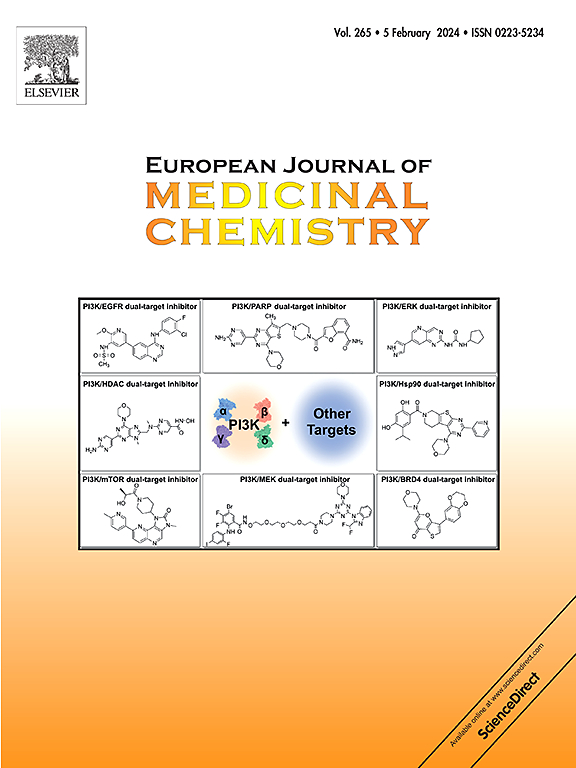Tetracationic tetraaryltetranaphtho[2,3]porphyrins for photodynamic inactivation against Staphylococcus aureus biofilm
IF 6
2区 医学
Q1 CHEMISTRY, MEDICINAL
引用次数: 0
Abstract
Antimicrobial photodynamic therapy (aPDT) has emerged as a promising strategy for addressing bacterial infections, particularly those involving biofilm formation. The electrostatic attraction between the negatively charged bacterial cell walls and the cationic charges of photosensitizers facilitates the accumulation of PSs on bacterial surfaces, thereby enhancing aPDT efficacy. In this study, three series of tetracationic tetraaryltetranaphtho[2,3]porphyrins (TNPs), each incorporating different cationic groups with alkyl chains of varying lengths, were designed and synthesized. Their photodynamic inactivation efficacy against S. aureus, E. coli and C. albicans was evaluated, respectively. These TNPs exhibited strong absorption at ∼730 nm with high molar extinction coefficients (>51,500 L·mol−1·cm−1), fluorescence emission at ∼758 nm and efficient singlet oxygen generation capabilities. Among them, TNPs with shorter alkyl chains (I1, II1 and Ⅲ1) exhibited enhanced phototoxicity against planktonic microbes, with I1 (containing pyridinium substituents) showing the highest activity. These three compounds effectively disrupted mature S. aureus biofilms, with Ⅲ1 (bearing diethylmethylammonium groups) demonstrating superior biofilm eradication capabilities. These findings highlight the dual antibacterial and biofilm-disrupting potential of these Ar4TNP derivatives. Furthermore, their selective toxicity toward bacterial cells over mammalian cells at therapeutic doses provides a foundation for developing safer antimicrobial agents, offering promising alternatives to antibiotics for tackling drug-resistant pathogens and persistent biofilm-associated infections.


求助全文
约1分钟内获得全文
求助全文
来源期刊
CiteScore
11.70
自引率
9.00%
发文量
863
审稿时长
29 days
期刊介绍:
The European Journal of Medicinal Chemistry is a global journal that publishes studies on all aspects of medicinal chemistry. It provides a medium for publication of original papers and also welcomes critical review papers.
A typical paper would report on the organic synthesis, characterization and pharmacological evaluation of compounds. Other topics of interest are drug design, QSAR, molecular modeling, drug-receptor interactions, molecular aspects of drug metabolism, prodrug synthesis and drug targeting. The journal expects manuscripts to present the rational for a study, provide insight into the design of compounds or understanding of mechanism, or clarify the targets.

 求助内容:
求助内容: 应助结果提醒方式:
应助结果提醒方式:


